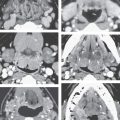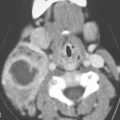Masticator Space, Buccal Space, and Infratemporal Fossa Infections and Other Inflammatory Conditions
KEY POINTS
- Magnetic resonance imaging and computed tomography provide the critical and usually definitive data needed in the diagnosis and management of masticator space, buccal space, and infratemporal fossa infections and noninfectious inflammatory conditions.
- Computed tomography–guided tissue sampling may be useful in the management of these infections.
INTRODUCTION
The masticator space (MS), buccal space (BS), and infratemporal fossa (IF) are discussed in this chapter as the sites of origin for inflammatory, and almost always infectious, conditions of the head and neck. These areas are most often secondarily involved sites in several common inflammatory conditions such as dental abscess (Chapter 97); spread of inflammatory salivary gland disease, especially of the parotid gland (Chapter 178); and spread of necrotizing otitis externa (Chapter 114) and other more uncommon causes of skull base osteomyelitis (Chapter 115). Secondary central skull base and transcranial spread from these processes via the MS is also possible. The spectrum of inflammatory conditions seen mainly originating in or involving the MS/IF and BS is summarized in this chapter.
Clinical Presentation
Infections and other inflammation typically cause pain that may manifest as trismus. The pain may be chronic and progressive or acute and severe and associated with fever and obvious facial swelling. Otalgia is also a common complaint. Tooth pain or findings in and around the external auditory canal may suggest a specific source of infection.
APPLIED ANATOMY
In the suprahyoid neck, the spaces adjacent to the visceral compartment are more numerous and structurally somewhat more complex than they are in the infrahyoid neck. Besides the MS, IF, and BS, they include the parapharyngeal space (pre- and retrostyloid divisions), retropharyngeal space, prevertebral space, parotid gland within its capsule, and the submandibular space (Figs. 142.3–142.7, 145.1, and 145.2). The parotid and submandibular glands are discussed in Chapter 175.
The primary skills necessary to interpret computed tomography (CT) and magnetic resonance (MR) studies of the deep spaces of the face and supra- and infrahyoid neck are common to these areas and include the following:
- Thorough knowledge of the anatomy.
- Realization that the differential diagnosis:
- Is primarily anatomically driven and largely based on analysis of the point of origin and involvement of normal anatomic structures illustrated for the MS in Figure 145.2.
- Requires a rudimentary knowledge of developmental disorders.
- Must take into account that disease may spread transcompartmentally because the process is aggressive and/or extends along existing anatomic structures (e.g., nerve, vessel, muscle bundles, and lymphatics). Transspatial spread is common in infectious and inflammatory disease.
- Is primarily anatomically driven and largely based on analysis of the point of origin and involvement of normal anatomic structures illustrated for the MS in Figure 145.2.
Specific Structures of Interest
The analysis of infectious and other inflammatory pathology in the MS/IF and BS depends on a thorough understanding of their relationship to the following structures (Figs. 145.1 and 145.2):
 Superiorly: Central skull base in the area of the foramen ovale and laterally from there
Superiorly: Central skull base in the area of the foramen ovale and laterally from there
 Inferiorly: Angle of the mandible at the attachment of the fascia that envelopes the muscles of mastication
Inferiorly: Angle of the mandible at the attachment of the fascia that envelopes the muscles of mastication
 Anteriorly: Fat of the BS that is continuous with the retroantral fat pad and eventually the inferior orbital fissure, the buccinator muscle, and the fat of the cheek deep to the superficial musculoaponeurotic system (SMAS)
Anteriorly: Fat of the BS that is continuous with the retroantral fat pad and eventually the inferior orbital fissure, the buccinator muscle, and the fat of the cheek deep to the superficial musculoaponeurotic system (SMAS)
 Posteriorly: Deep portion of the parotid gland, stylomandibular tunnel, and parapharyngeal spaces
Posteriorly: Deep portion of the parotid gland, stylomandibular tunnel, and parapharyngeal spaces
 Medially: Prestyloid parapharyngeal space (PSPS)
Medially: Prestyloid parapharyngeal space (PSPS)
 Laterally: Superficial portion of the parotid gland, zygomatic arch, superficial aponeurotic system of the face, and subcutaneous fat and skin
Laterally: Superficial portion of the parotid gland, zygomatic arch, superficial aponeurotic system of the face, and subcutaneous fat and skin
Spatial Boundaries
The MS is the major component of the IF (Fig. 145.1A–D). It is very important to recall that the parotid gland and MS share a common fascia. The fascial sheath of the muscles of mastication separates the MS from the BS anteriorly. The BS is contiguous superiorly with the retroantral fat pad, with that fat pad and the MS essentially making up the IF.
The MS comes into contact with the central skull base to and inclusive of the foramen ovale. Inferiorly, the MS comes to an end where its facial envelope attaches to the mandibular angle. It contains the mandible, making the mandibular dentition the most common source of infection in this space.
The MS can be subdivided into several smaller spaces, but such an approach is not used widely. It is useful to recognize that there is a subperiosteal or perimandibular compartment as well as several potential spaces between the muscles and related fascia of the MS.
The BS is contiguous with the fat deep to the SMAS anteriorly and inferiorly (Figs. 145.1E–H). It is related to both the maxilla and the mandible by the attachments of the buccinator muscle, making their dentition the most common source of infection in this space.
IMAGING APPROACH
Computed Tomography and Magnetic Resonance Imaging
The suprahyoid neck is studied in essentially the same manner as the nasopharynx is evaluated with magnetic resonance imaging (MRI) and CT. The specifics and relative value of using these studies in this anatomic region are reviewed in Chapter 184. Problem-driven protocols for CT and MRI are presented in Appendixes A and B. In general, MRI is more definitive than CT in the evaluation of deep space masses in the suprahyoid neck, and the images are usually of excellent quality especially above the hard palate.
Other
Ultrasound has no significant role to play in the evaluation of these infections. The approach with radionuclide studies depends on the specific aim of the examination. Most current usage is limited to bone/gallium scans for inflammatory pathology discussed in other chapters.
PATHOPHYSIOLOGY AND PATTERNS OF DISEASE AND DIFFERENTIAL DIAGNOSIS AS SEEN ON MAGNETIC RESONANCE IMAGING AND COMPUTED TOMOGRAPHY
Introduction
The MS has sometimes been subdivided into several smaller spaces, including the interpterygoid and perimandibular, but such an approach is not used widely. It is useful to identify abscesses as subperiosteal or perimandibular as well as whether they are spreading between the various muscles and related fascial spaces within and bordering the MS.1
The morphology and general pathophysiology of acute pyogenic infections and those that are more indolent are discussed in Chapters 13 and 16. That of dental infections is presented in Chapter 97 and that of the skull base infections that secondarily spread to these spaces are presented in Chapters 114 and 115.
The initial evaluation of a likely infection in the MS or BS should determine whether it is of dental or nondental origin.
Differential Diagnosis
The differential diagnosis is usually not an issue in these infections since the presenting clinical circumstances are almost always obvious. Occasionally, an indolent infection will mimic one of the fibromatoses or a reactive fibrous process such as nodular fascitis, lymphoma, or sarcoma. The diagnostic process will typically center on the source, extent, and complications related to the infection.
Analysis of Disease Spread
The method of disease analysis is driven by an orderly process of relatively simple observations that may be made on the basis of MR and/or CT studies (Chapters 13 and 16) that first relate to the morphology of the disease, which will most often confirm an infection suspected clinically. The site of origin should then be established and followed by a detailed analysis of the spaces involved and important associated changes. The suggested process is as follows:
- Determine whether the process involves single or multiple spaces (Figs. 146.1–146.4).
- If single, determine which space is involved. In this chapter, it would be centered in the MS or BS based on making the following observations with regard to vectors of structural involvement and “travel” of the phlegmon and/or pus.
- Superiorly, the infection/inflammation will approach the central skull base in the vicinity of the foramen ovale (Figs. 146.1 and 146.5).
- Inferiorly, the infection/inflammation will track toward the mandibular angle, often contained by the fascia enveloping the space (Figs. 146.1 and 146.5).
- Medially, the fat between the MS and PSPS may be edematous or abscess will also involve that space (Figs. 146.1–146.5)
- Laterally, the process thickens the parotidomasseteric fascia and will cause the parotid gland and skin to become at least edematous, sometimes leading to the mistaken impression that it is primarily one of parotid origin (Figs. 146.1, 146.4, and 146.5)
- Posteriorly, infected material will displace and also involve the parotidomasseteric fascia with secondary parotid gland swelling and may compress the structures of the PSPS and retrostyloid parapharyngeal space (RSPS) while encroaching on the stylomandibular tunnel. If the PS is involved, the infection can spread to the deep infrahyoid neck along the carotid sheath via the RSPS and/or to the submandibular space via the PSPS (Figs. 146.1 and 146.4).
- Superiorly, the infection/inflammation will approach the central skull base in the vicinity of the foramen ovale (Figs. 146.1 and 146.5).
- Identification of associated findings such as osteomyelitis, vascular thrombosis, and intracranial spread (either direct or vascular) (Fig. 146.5)
Relative Frequency of Pathology
From the process just described, the correct clinical information can be derived nearly all the time and atypical pathologies or sources of infection anticipated, especially whenever the process or associated finding may be atypical in its pattern or morphology.
MS and BS space infections are common. The vast majority of MS infections are of dental, usually mandibular, origin (Fig. 146.2). Those primarily in the BS are most likely due to the teeth in the maxilla. Less common nondental jaw, sinus, or skin infections can also be the cause (Fig. 146.5). This is especially true of fungal infections that may present as an aggressive sinus infection, with the diagnosis based on only early infiltration of the retroantral fat pad in light of otherwise nonaggressive antral disease, most typically in immune-compromised or diabetic patients.

FIGURE 146.1. Contrast-enhanced computed tomography study of a patient with inflammatory pseudotumor. A, B: The infiltrating process has an inflammatory morphology and involves the masticator space (MS) as well as the extent of the infratemporal fossa (IF) and in (A) is seen extending into the buccal space. In (B), the process extends to the skull base contained by the fascia of the MS and sparing the parapharyngeal fat to some extent (arrow) and extending to but not crossing the plane of the MS below the foramen ovale (arrowhead). C: Coronal image showing the process contained by the fascia of the MS inferiorly (arrowheads) and extending superiorly above the level of the zygomatic arch to involve the temporalis muscle as the superior continuation of the muscles of mastication within the MS (arrow). D: The process is seen extending to the limits of the IF by infiltration of the retroantral fat and from there extending into the pterygopalatine fossa (arrows). E: The process can be seen to have an inflammatory morphology at its margins. It also shows variable enhancement. Note that the fascia of the MS creates a boundary between the process in the MS and the parapharyngeal fat (arrow). F: The mass causes some swelling of the common fascia between the parotid gland and MS (arrows) and may be resulting in some dilatation of the main parotid duct or some periductal swelling (arrowhead). This emphasizes the linkage between the parotid gland capsule and the MS as the parotidomasseteric fascia.
Stay updated, free articles. Join our Telegram channel

Full access? Get Clinical Tree








